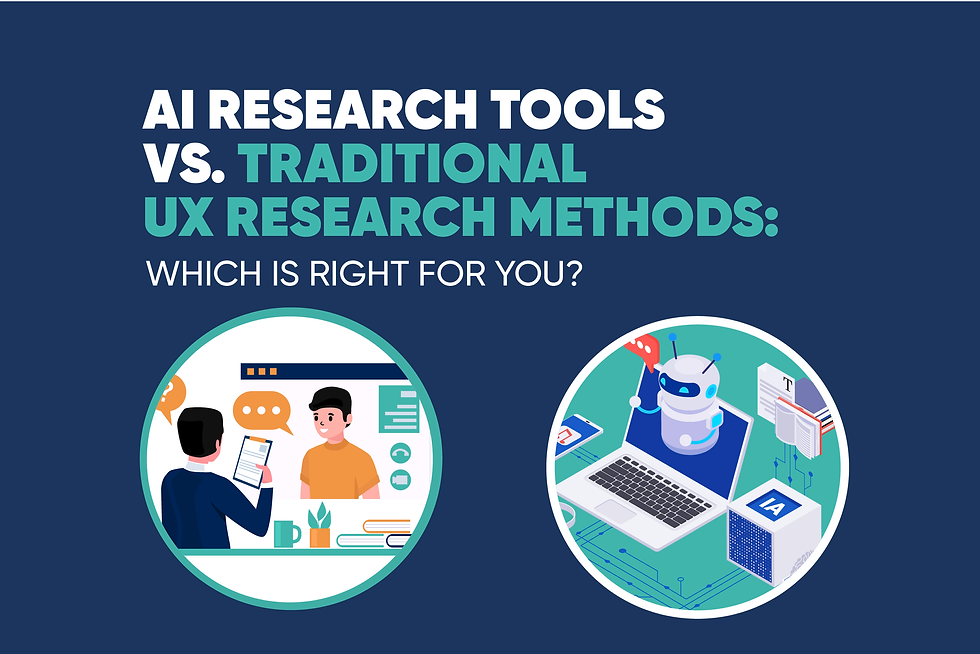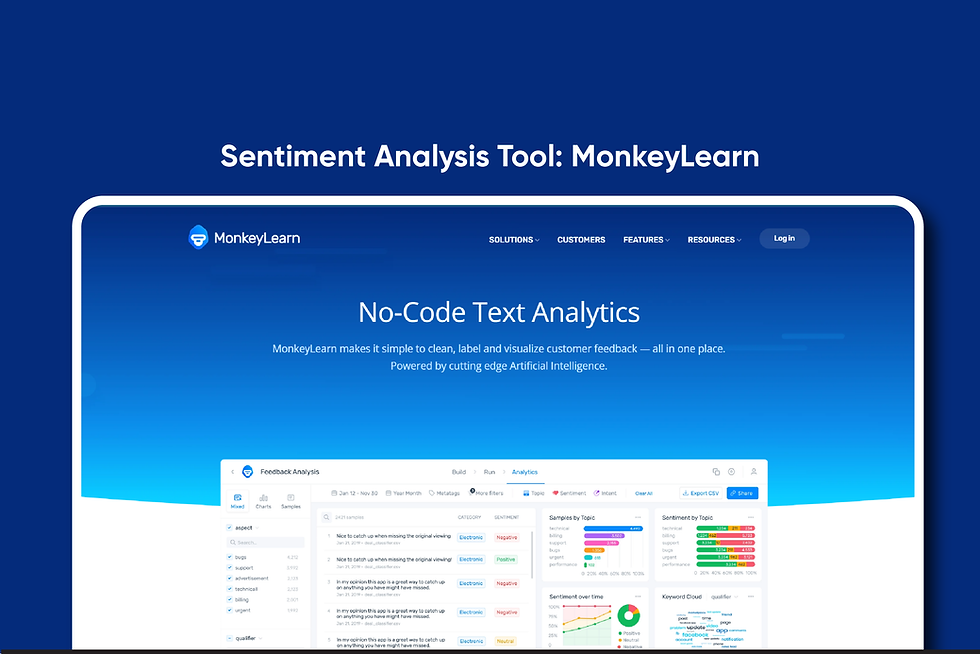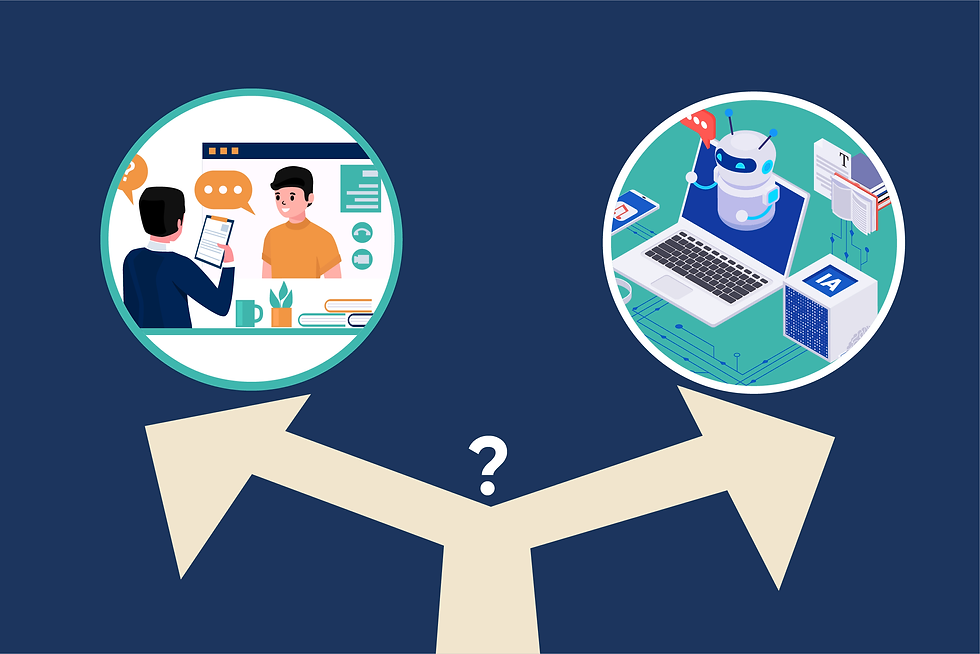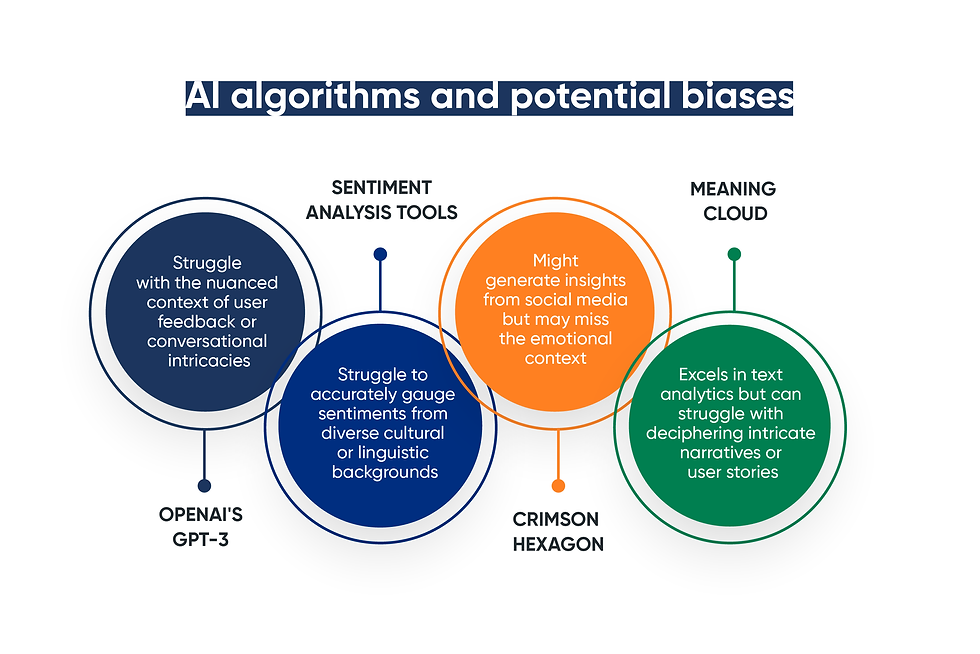AI Research Tools vs. Traditional UX Research Methods: Which is Right for You?
- Deborah Seun-Lawal
- Oct 4, 2023
- 13 min read
Updated: Aug 12, 2024

AI and UX research are vital in shaping technology and design in today's digital landscape. With its ability to analyze data and make predictions, AI offers valuable insights into consumer behavior and preferences.
It's understandable to be cautious about AI-powered tools claiming to assist UX researchers. For example, some tools may offer to analyze and tag data without input from the user, but the issue is that user experience research doesn't happen in a vacuum. It's either the same user experience research flow, genuine data from a user experience research method, or made-up data.
To create engaging and satisfying user experiences, designers need to understand human needs, behaviors, and expectations. This involves gathering insights through interviews, surveys, and observing behavior to determine what motivates user decision-making.
Using this knowledge, designers can create intuitive and user-friendly interfaces. So, traditional UX research scientific usability testing methods are still important in the design product development process to ensure the interfaces meet the users' needs.

However, in the 2023 State of User Research report, 20% of researchers currently use AI in their user research, and an additional 38% plan to incorporate it. These figures emphasize the growing interest in AI UX research tools among UX researchers and suggest they may play a role in the field.
Both approaches have unique strengths and limitations, and choosing the right research methodology that aligns with your goals, resources, and ambitions is essential. This article will provide you with an in-depth exploration of the various AI research vs traditional UX research methods to help you make an informed decision that will drive your success.
Table of Content
AI Research Tools

AI research tools are powerful instruments revolutionizing how we comprehend data and glean insights—using AI in UX research helps to scrutinize vast information and uncover patterns, trends, and correlations that might evade the human eye. Here, we'll delve into the key categories of AI research tools, shedding light on their functionalities and real-world applications.
Natural Language Processing (NLP). At the frontier of measuring and improving user experience with AI research tools, Natural Language Processing (NLP) enables extracting meaning from human language. NLP algorithms analyze written or spoken language, unraveling sentiments, intentions, and context. NLP's potential is exemplified in tools like "IBM Watson Natural Language Understanding," which employs machine learning to decode text and extract insights. Researchers can distill user feedback, reviews, or surveys by employing NLP, unveiling valuable sentiments and perceptions that guide design decisions.
Sentiment Analysis Tools. In the quest to decipher emotions embedded in textual data, sentiment analysis tools shine. These tools employ AI to discern whether a text conveys a positive, negative, or neutral sentiment. For instance, "MonkeyLearn" offers a user-friendly interface to analyze text sentiment, enabling researchers to gauge public opinion, customer feedback, and social media conversations. By tapping into sentiment analysis, UX researchers can grasp user attitudes and reactions to products and experiences, steering design refinements.
Predictive Analytics Solutions. Predictive analytics harness AI's prowess to anticipate future outcomes based on historical data. Tools like "RapidMiner" empower researchers to construct predictive models without diving into complex coding. By training on historical user and behavior patterns, predictive analytics can forecast user preferences, enabling designers to tailor experiences to user inclinations.
Image Recognition and Analysis Tools. In an increasingly visual digital landscape, image recognition tools hold significant value. Tools like "Google Cloud Vision" utilize AI to interpret visual content, distinguishing objects, faces, and context. This technology translates into user-centric applications, from identifying user engagement with design elements to aiding content categorization.
Virtual User Testing Platforms. Virtual user testing platforms like "UserTesting" offer a virtual space for user interaction with prototypes. AI aids usability tests by capturing user behavior and feedback, providing UX researchers with actionable insights. This accelerates the usability testing phase, allowing it to iterate and enhance designs scientifically testing more swiftly.
AI-Enhanced Data Analysis. Data analysis tools enhanced by AI, like "Tableau," enable researchers to sift through vast datasets effortlessly. These tools uncover trends and correlations, highlighting critical data that inform decision-making. By understanding the diverse categories of AI research tools and their applications, UX researchers can use them effectively to glean insights, accelerate processes, and craft user-centric experiences.
Benefits of AI Research Tools
AI research tools bring many advantages that streamline the research process, offering efficiency, precision, and depth. Let's delve into the tangible benefits that make these tools indispensable companions for modern UX researchers.

Speed and Efficiency in Data Analysis: AI research tools wield computational might to swiftly analyze copious amounts of data that would otherwise be a formidable undertaking for human researchers. Take, for instance, "MonkeyLearn's Text Analysis API." This tool employs machine learning to dissect text data at remarkable speeds. Whether it's user feedback, online reviews, or social media conversations, AI-powered tools expedite the extraction of insights, enabling researchers to focus on interpretation rather than grappling with data overload.
Automation of Repetitive Tasks: The struggle of repetitive tasks can stifle the research process. AI research tools liberate researchers from these shackles by automating mundane tasks. Tools like "UiPath" facilitate the creation of automated workflows that navigate through routine data collection and processing. Researchers can allocate their time and expertise to higher-level analysis and strategic decision-making by offloading such tasks to AI.
Handling Large Datasets for Insights: In today's data-rich world, harnessing insights from extensive datasets is crucial. AI research tools excel in this arena, effortlessly sifting through voluminous data to uncover hidden patterns and trends. For instance, "IBM SPSS Statistics" leverages AI-driven algorithms to manage and analyze extensive datasets efficiently. This capability expedites the research process and ensures no valuable insights are undiscovered.
Precision in Pattern Recognition: AI research tools exhibit an exceptional aptitude for recognizing intricate patterns that might elude human observation. Take image recognition tools such as "Clarifai." These tools scrutinize images for subtle visual cues, facilitating the identification of user behaviors and preferences. This precision translates into sharper insights, enabling designers to refine interfaces accurately.
Personalization at Scale: Delivering personalized experiences to users on a broad scale is a challenging endeavor. AI research tools surmount this obstacle by analyzing user interactions and tailoring experiences accordingly. "Dynamic Yield," for example, deploys AI to customize content and interfaces based on user behavior, heightening engagement and satisfaction. Incorporating AI research tools into the UX research arsenal isn't just a nod to technological advancement; it's a pragmatic decision that streamlines processes, enhances insights, and ultimately fosters the creation of user-centric designs.
Limitations of AI Research Tools
While AI research tools offer remarkable advantages but aren't without constraints, understanding these limitations is crucial for maintaining a balanced perspective and making informed decisions about their implementation in UX research.

Lack of Contextual Understanding: AI research tools operate on algorithms, processing data based on patterns and predefined rules. However, they lack the inherent understanding that humans possess. A tool like "OpenAI's GPT-3," while capable of generating coherent text, may struggle with the nuanced context of user feedback or conversational intricacies. This can lead to misinterpretations and erroneous conclusions, underscoring the necessity of human intuition in research.
Potential Biases in AI Algorithms: The data AI algorithms learn from can carry inherent biases. AI research tools may inadvertently perpetuate these biases, leading to skewed results. For instance, sentiment analysis tools can struggle to accurately gauge sentiments from diverse cultural or linguistic backgrounds, causing inaccuracies in insights. The potential for biased outcomes underscores the importance of diligent monitoring and refining AI algorithms.
Human Touch and Creativity Missing in Interpretation: Interpreting research findings isn't just about uncovering patterns in user flow; it's about discerning the underlying motivations and emotions that shape user behavior. AI research tools lack the capacity for empathy and the ability to identify subtle human nuances. Tools like "Crimson Hexagon" might generate insights from social media but may miss the emotional context that human researchers can perceive. The absence of human touch and creativity can hinder the depth of interpretation.
Complexity of Handling Unstructured Data Collected: AI research tools thrive on structured data with clear patterns. These tools can falter when confronted with unstructured data, such as open-ended survey responses or qualitative feedback. "MeaningCloud," for instance, excels in text analytics but can struggle with deciphering intricate narratives or user stories. The intricate nature of human communication can pose a challenge that AI tools find difficult to overcome.
Lack of Common Sense and Intuition: Human researchers often apply common sense and intuition to their analysis and collect data, allowing them to detect irregularities or unusual trends. AI research tools, however, lack this inherent human capacity. This deficiency can lead to misinterpretations of anomalies or overlook subtle shifts in data that hold crucial significance.
Acknowledging these limitations doesn't discount the value of AI research tools but emphasizes the importance of a complementary approach. By understanding when and how to apply AI tools alongside human expertise, researchers can harness the strengths of both to create a more comprehensive and accurate picture of user behavior, preferences, and motivations.
Traditional UX Research Methods
Traditional UX and user experience research methods are steadfast pillars in the technology and design landscape, grounded in understanding the intricate dance between how users interact with and technology.
These common UX research methods encompass a range of user-centered approaches that dive deep into user behaviors, needs, and preferences. Let's delve into these user experience research methods, unveiling their significance in shaping user experiences.

User Interviews and Surveys: User interviews and surveys are quintessential methods for conducting user research and gathering direct insights from users. They facilitate the exploration of user motivations and aspirations. Through thoughtful questioning and active listening to the target audience, researchers uncover perspectives and generate ideas that aid in refining designs. Techniques like "Contextual Inquiry" take interviews and survey tools further by observing users in their natural environment, shedding light on their real-world behaviors and challenges.
Usability Testing: Usability and usability testing tests designs by observing user interactions with prototypes or products. By watching users navigate interfaces, researchers identify areas of confusion, friction, or delight. "Moderated Usability Testing" involves a UX researcher guiding users through tasks by testing, while "Remote Unmoderated Testing" offers scalability by allowing users to complete tasks and test independently. Usability testing ensures that designs resonate with users and are intuitive to navigate.
Persona Development process: Personas encapsulate archetypal user profiles, aiding in designing for specific user segments. By creating user personas based on research findings, such as "Jane, the Tech-Savvy Traveler," designers gain insight into different user focus groups'' motivations, goals, and pain points. This research method then guides the creation tree testing of tailored experiences that cater to diverse user needs.
Card Sorting and Journey Mapping: Card sorting involves users organizing content into categories, shedding light on intuitive information architecture. Journey mapping greatly delves into the user's end-to-end user experience research, pinpointing touchpoints, emotions, and pain points. These methods, like "Optimal Workshop's Treejack" for card sorting and "UXPressia" for journey mapping, offer visual tools for collaborative analysis and design iteration.
Ethnographic Studies: Ethnographic studies entail immersing researchers within the user's real life and environment, observing their behaviors and routines. This deep dive into user contexts unveils insights that shape empathetic designs. Tools like "DScout" enable remote ethnographic studies, bridging geographical gaps and broadening the scope of research.
Significance in Understanding User Behavior and Needs
Traditional UX research methods are pivotal in understanding user behavior, needs, and expectations. They allow researchers to enter users' shoes, cultivating empathy and informing design decisions.
By comprehending user motivations, pain points, and aspirations, designers can create experiences that resonate profoundly.
In an era of rapid technological evolution, traditional UX research methods ground the design process in human understanding. These behavioral research methods empower designers to bridge the gap between innovation and user satisfaction, crafting interfaces that seamlessly match user needs.
Advantages of Traditional UX Research Methods

In-depth Understanding of User Motivations: Traditional UX research methods excel in unearthing the intricacies of user motivations. Through user interviews and surveys, researchers gain insights into why users behave as they do. This depth of understanding enables designers to create experiences that align with user desires, whether crafting an intuitive user interface or tailoring content to address specific user needs.
Human Empathy in Research Process: At the core of traditional UX research methods lies human empathy. Researchers interact directly with users, forging connections that transcend data points. This empathetic approach nurtures an authentic comprehension of user pain points, aspirations, and emotions. Techniques like ethnographic studies and user interviews enable researchers to view the world through users' eyes, enriching the design process with a human touch.
Flexibility to Adapt to Complex Scenarios: The beauty of traditional UX research methods lies in their adaptability. Whether the challenge involves a complex interface or an intricate user journey, these methods rise to the occasion. Card sorting and journey mapping offer flexible frameworks that accommodate many scenarios. This adaptability empowers researchers and designers to tackle intricate challenges with confidence.
Challenges with Traditional UX Research

Time-consuming Data Collection and Analysis: While traditional UX research methods offer profound insights, they come with a time investment. Data collection through interviews and surveys can be time-consuming, requiring meticulous planning and execution of user research by each research technique and method. Similarly, the analysis phase of user research demands thorough scrutiny to extract meaningful insights from the collected data.
Limited Scalability for Large Datasets: In a data-rich landscape, the limitations of traditional UX research methods become apparent when dealing with large datasets. Scaling up these methods to accommodate vast amounts of data can be challenging and resource-intensive. As datasets grow, the intricacies of individual interactions can get lost, making it harder to derive actionable insights.
Subjective Interpretation of Results: Traditional UX research methods are susceptible to subjective interpretation. Different researchers may analyze the same data and arrive at varying conclusions. This subjectivity can introduce uncertainty into the design process, necessitating clear communication and collaboration among research teams to ensure consistent insights.
Balancing Strengths and Challenges
While traditional UX research methods offer invaluable insights, their strengths are accompanied by challenges. These challenges underline the importance of approaching research with a balanced perspective.
By acknowledging the advantages and limitations of these methods, researchers and designers can strategically integrate them into their processes, like knowing the difference between user research and UX research. Understanding this distinction is crucial when navigating the diverse landscape of research methodologies. This will ensure that human empathy remains at the heart of user-centric design.
Finding the Right Approach for Your Needs

Considerations for Choosing Between AI and Traditional Methods
Project Goals and Scope: The choice between AI user research techniques and tools and traditional UX or user experience research methods hinges on project goals and scope. If your aim is swift data analysis and pattern identification, AI tools like "MonkeyLearn" for sentiment analysis or "IBM Watson Natural Language Understanding" for textual insights might align well. Conversely, traditional user research methods such as user interviews or ethnographic studies would be apt if you seek an in-depth understanding of user motivations.
Available Resources (Time, Budget, Expertise): Resource allocation plays a pivotal role in the decision-making process. AI research tools excel in efficiency, making them suitable for time-sensitive projects. However, weighing this efficiency against factors like budget constraints and the expertise needed to wield these tools effectively is essential. Traditional methods often demand more time but can be more budget-friendly and don't necessarily require advanced technical skills.
Type of Data Being Analyzed (Qualitative vs. Quantitative): The nature of the data being analyzed guides the choice between AI and traditional methods. If you're dealing with quantitative data, such as large-scale surveys or numerical metrics, AI tools like "RapidMiner" for predictive analytics can unearth trends effectively. On the other hand, qualitative data, like open-ended responses or nuanced user stories, may be better suited to traditional quantitative methods that enable deeper exploration and human interpretation of qualitative data.
Hybrid Approaches: Blending AI and Traditional Methods

Combining Strengths for Comprehensive Insights: Hybrid approaches that merge the strengths of AI and traditional methods offer a nuanced perspective. For instance, you could use sentiment analysis tools like "MonkeyLearn" to quickly assess user sentiments, followed by in-depth user interviews to contextualize those sentiments. This blend allows for rapid insights and more qualitative data understanding, offering a more holistic picture of user needs and emotions.
Examples of Successful Hybrid Approaches: A notable example of a successful hybrid approach involves combining AI-driven data analysis with traditional user testing. "UsabilityHub" provides automated insights into how users interact with interfaces while combining it with moderated usability testing adds qualitative depth. Another hybrid scenario could involve using AI tools like "Google Cloud Vision" to analyze visual content, supplemented by ethnographic studies to understand the emotional context behind user interactions.
Striking the Right Balance
The decision to employ AI research tools, traditional UX research methods, or a hybrid approach necessitates careful consideration. Striking the right balance requires aligning the chosen approach with your project's objectives, available resources, and the nuances of the data you're working with.
By thoughtfully weighing these considerations, you can craft a full user research method and strategy that brings insights to the forefront and guides the creation of user-centric designs.
The Role of Ethics and Diversity

Addressing Bias and Ethical Concerns in AI
While AI research tools hold tremendous potential, they are not impervious to biases lurking within data. These biases can stem from historical data imbalances, reflecting societal inequalities.
For instance, AI sentiment analysis tools might misinterpret nuanced emotions expressed in diverse cultures, inadvertently producing skewed insights. It's paramount to acknowledge that AI is only as unbiased as the data it's trained on.
Diversity in data is a potent antidote to bias in AI algorithms. Ensuring representation across gender, race, culture, and socioeconomic backgrounds fosters more accurate insights.
Tools like "IBM Watson's AI Fairness 360" address fairness concerns by assessing and mitigating bias in AI models. By championing diversity in data, researchers can nurture AI tools that offer insights devoid of discrimination.
Human-Centered Design in UX Research Methods
Prioritizing Inclusivity and Empathy in the Design and Development Process
Human-centered design is grounded in the principles of inclusivity and empathy. By placing the user at the core of design decisions, designers craft experiences that resonate with a diverse user base.
Tools like "Inclusive Components" aid in designing interfaces that cater to the various target audiences, users' audiences, and users' various accessibility needs, ensuring no user is left behind. This approach elevates the user experience, fostering a sense of belonging and usability.
Leveraging Traditional Methods for Better Understanding
Traditional UX research methods are well-aligned with the principles of human-centered design. Techniques like user interviews and ethnographic studies enable researchers to tap into user emotions, contexts, and experiences.
This more quantitative data and qualitative user research provide a richer understanding of user needs, which fuels more empathetic design decisions. The insights garnered through these methods humanize the design process, ensuring that technology remains a tool for people rather than a detached entity.
A Harmonious Blend
Ethics and diversity underscore the essence of human-centric design. Addressing biases in AI algorithms and embracing diverse data create a foundation for inclusive and unbiased insights.
At the same time, leveraging traditional UX research methods enhances empathy and understanding. This harmonious blend of ethical considerations and human-centered principles shape designs that resonate with users across cultures, backgrounds, and abilities, championing the true spirit of user-centric technology.
Final Thoughts
Embracing a Holistic Approach to Research Methods
The choice between AI research tools and traditional UX research methods is multifaceted in the dynamic tech and design space.
Each approach carries distinct strengths and challenges, from AI's efficiency to traditional methods' empathy.
As you embark on your research journey, remember that a well-rounded perspective and design process are paramount. By considering your project goals, available resources, and the nuances of your data, you can craft a research strategy that resonates with the heart of human-centered design.
Are you looking to advance your career and drive innovation? Explore Brave Achievers' Product Design bootcamps, offering cutting-edge UI/UX design and product management skills. Our BUX Platform empowers businesses with dedicated design teams, crafting exceptional products. Join our dynamic community, advocating for inclusion and diversity in tech. Together, we can achieve remarkable feats and make a tangible impact on the world.

Comments